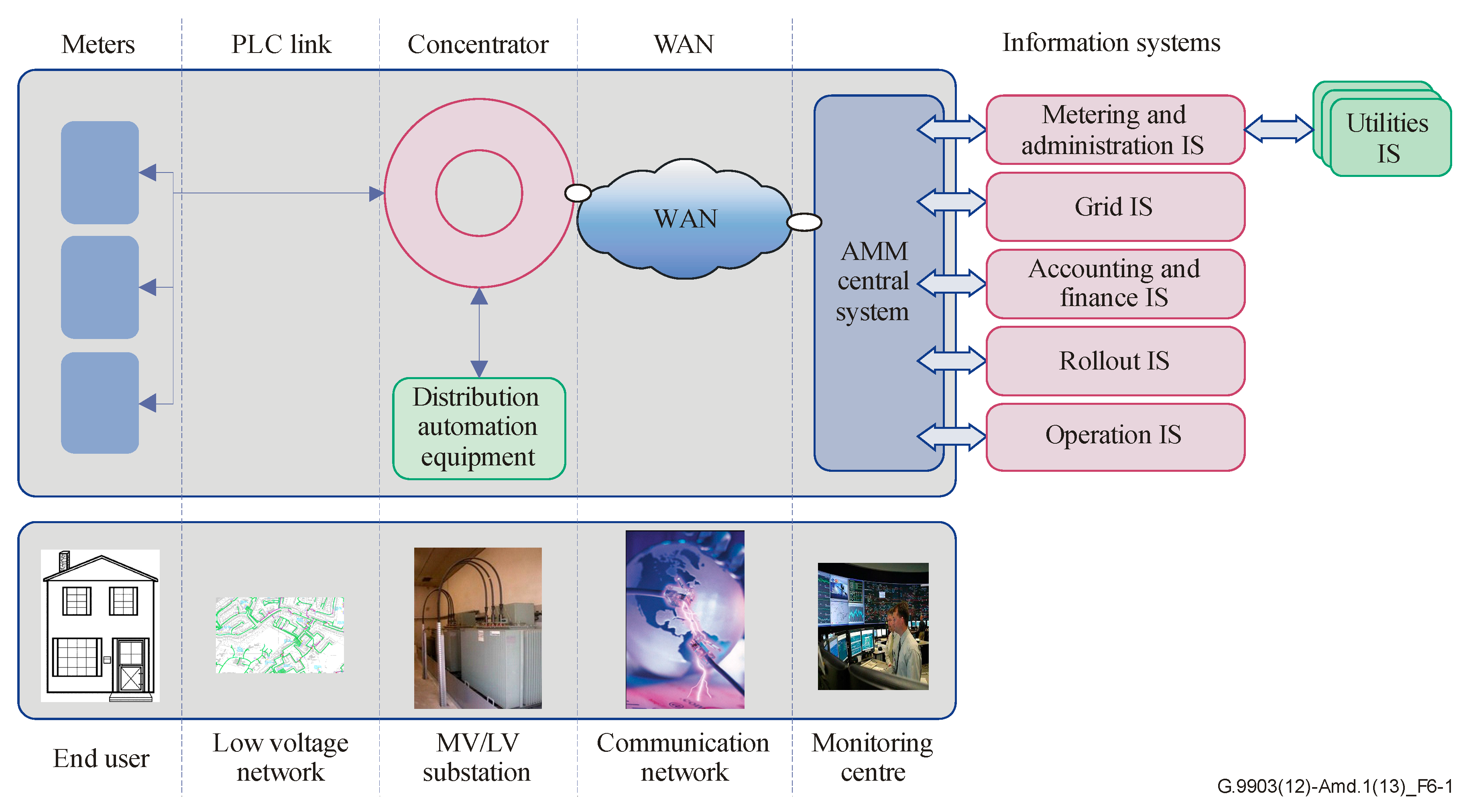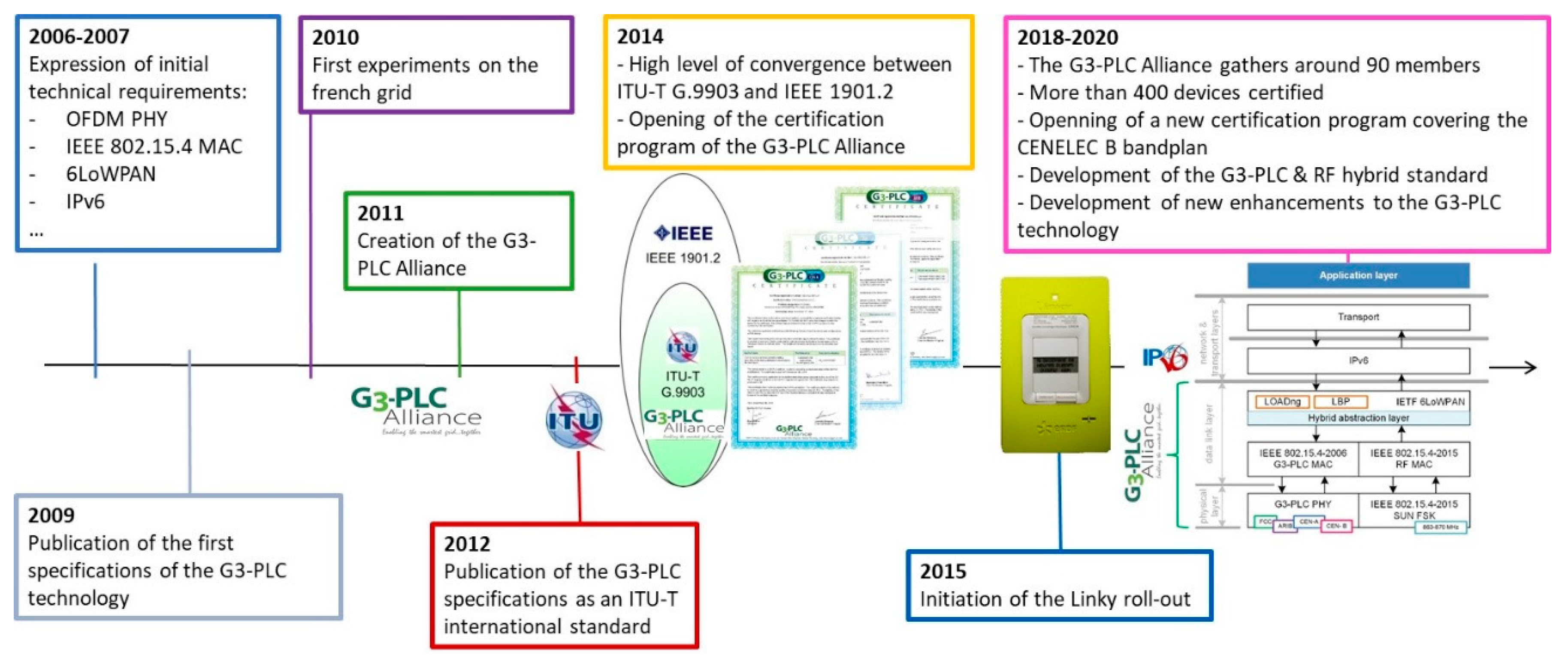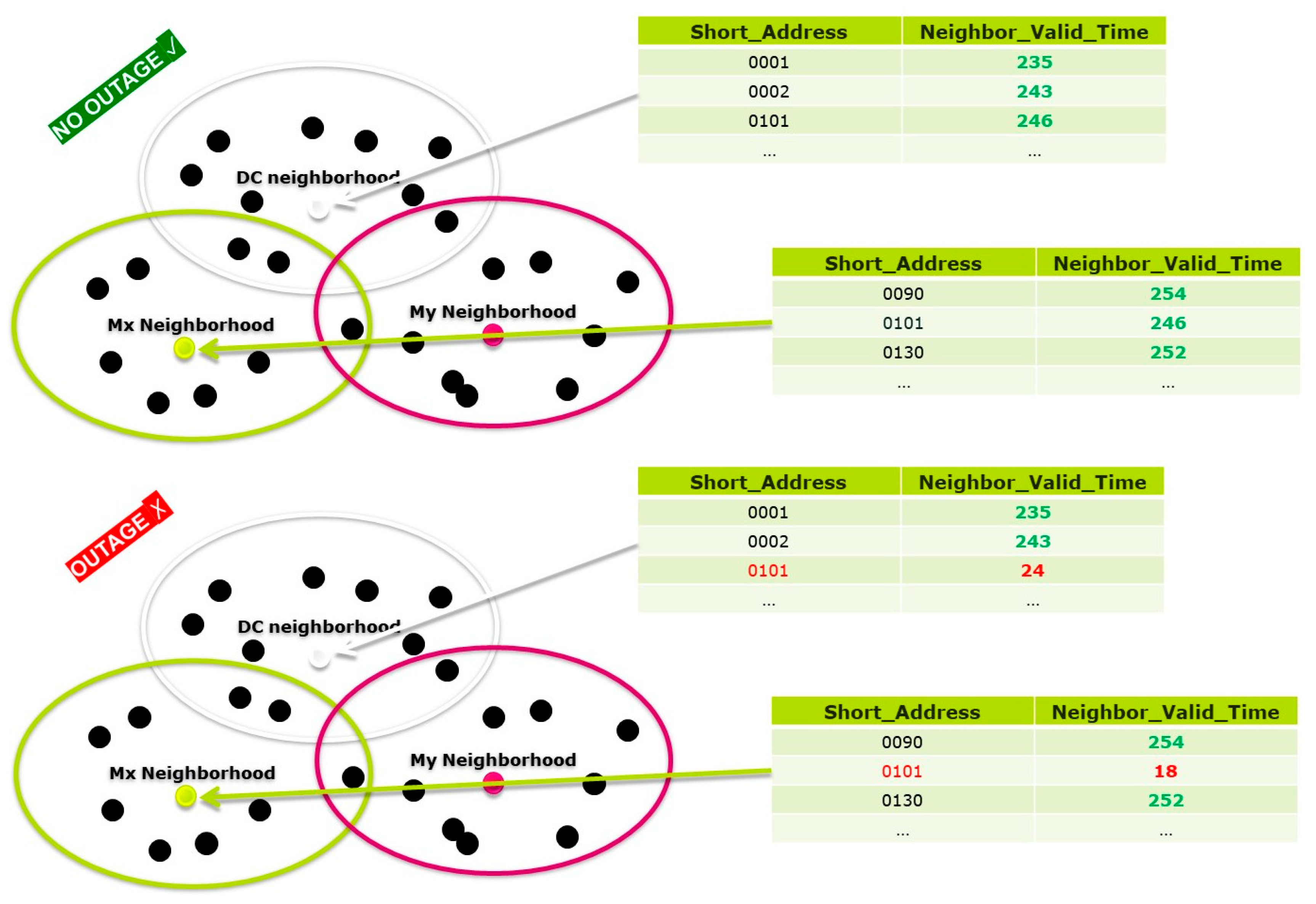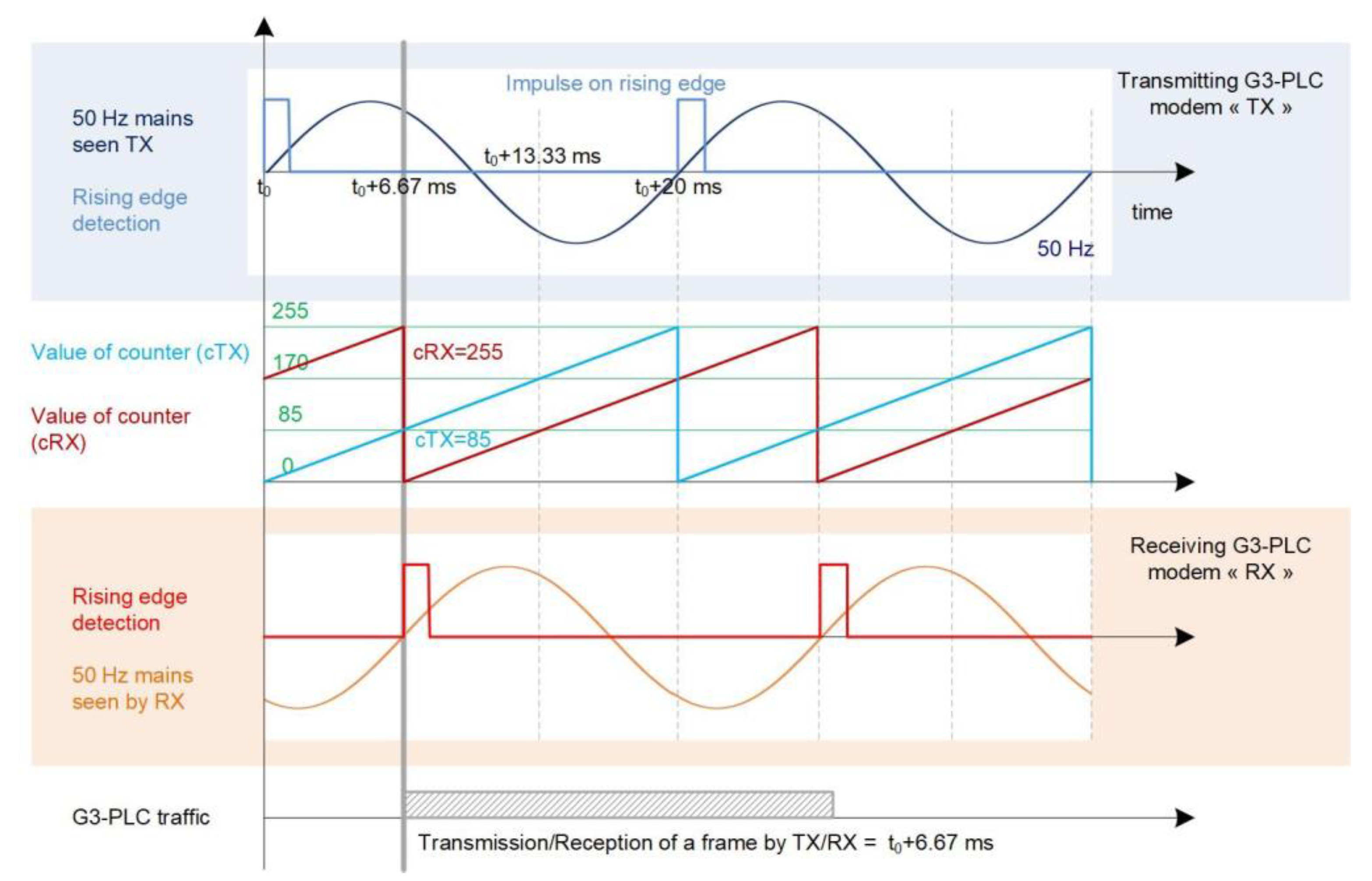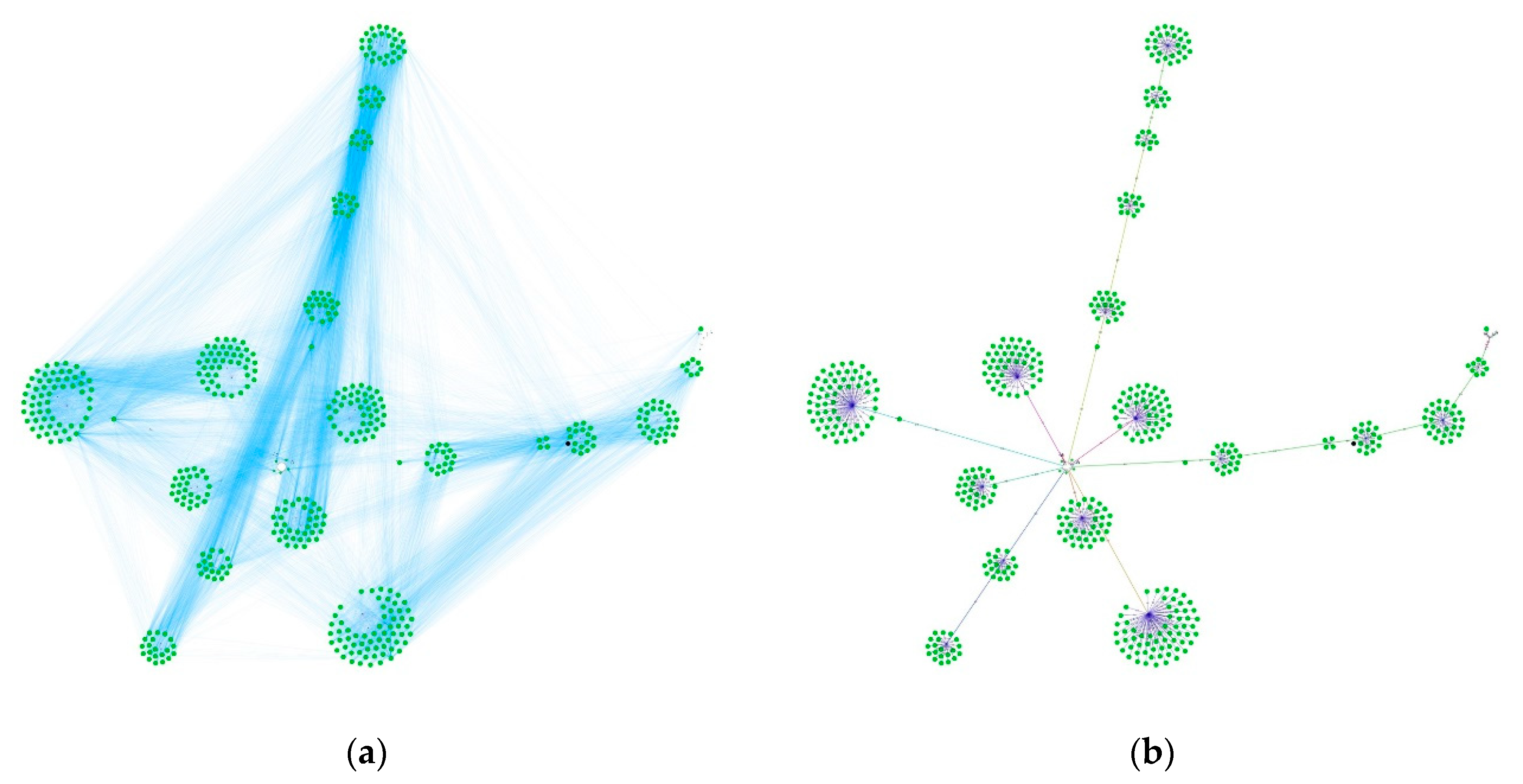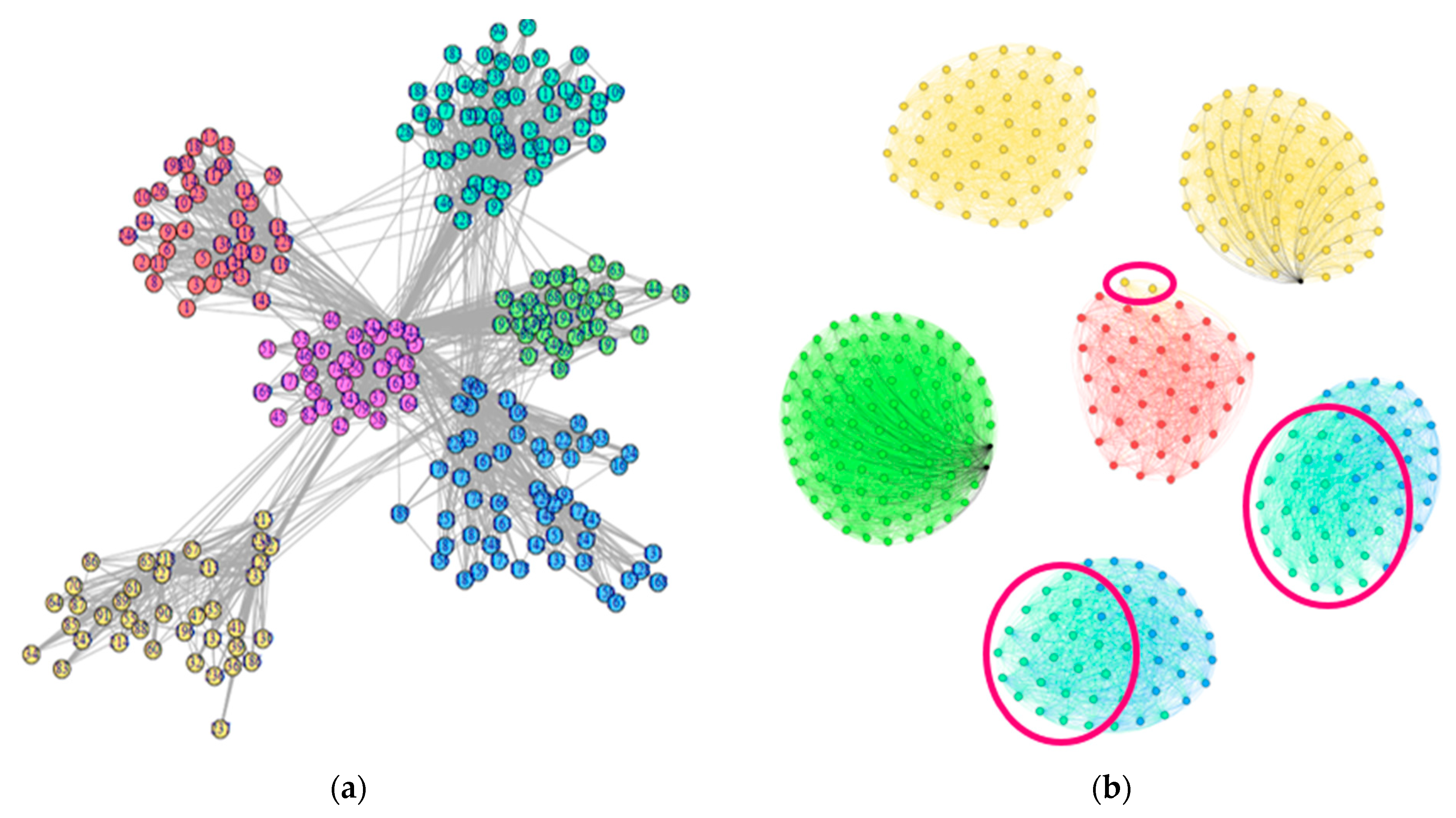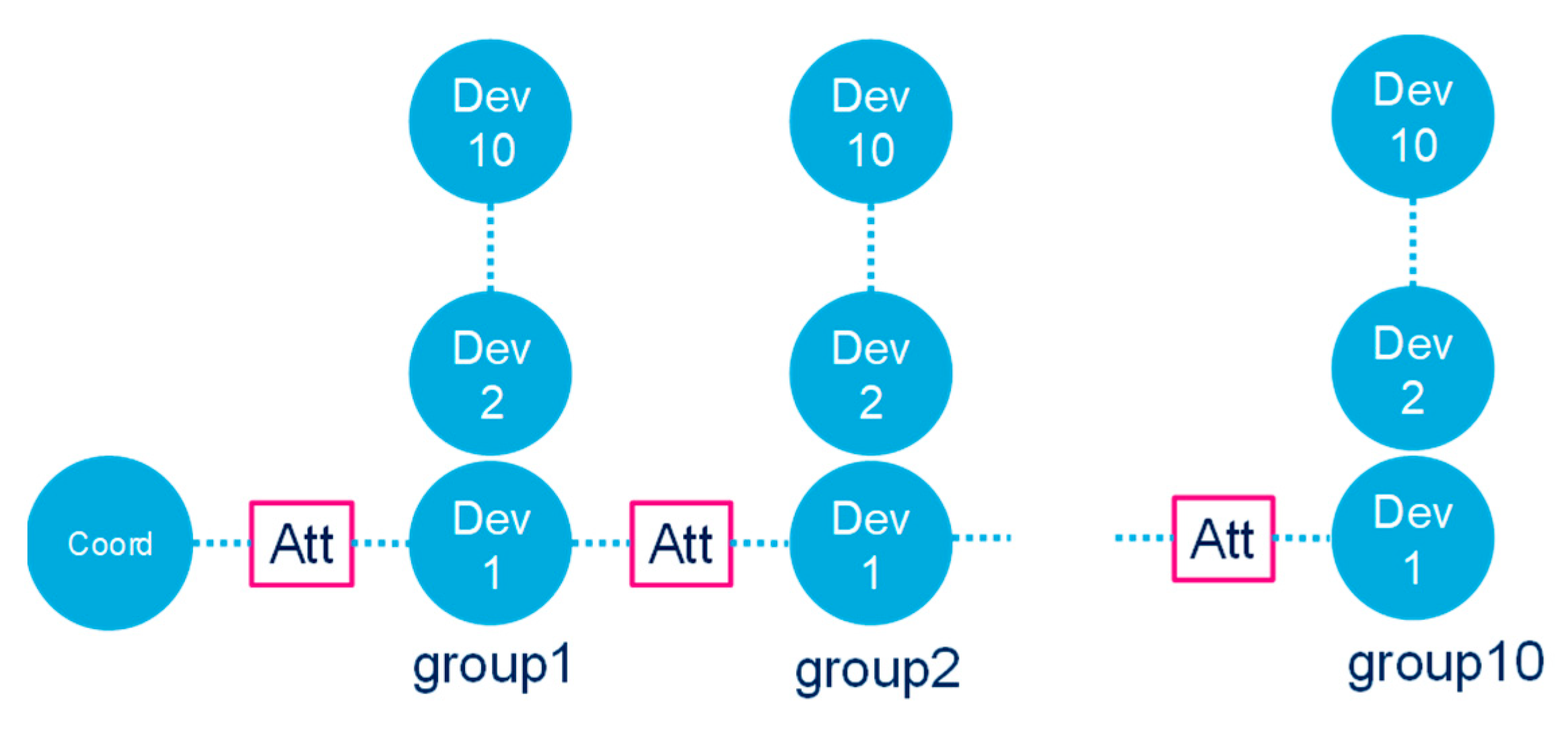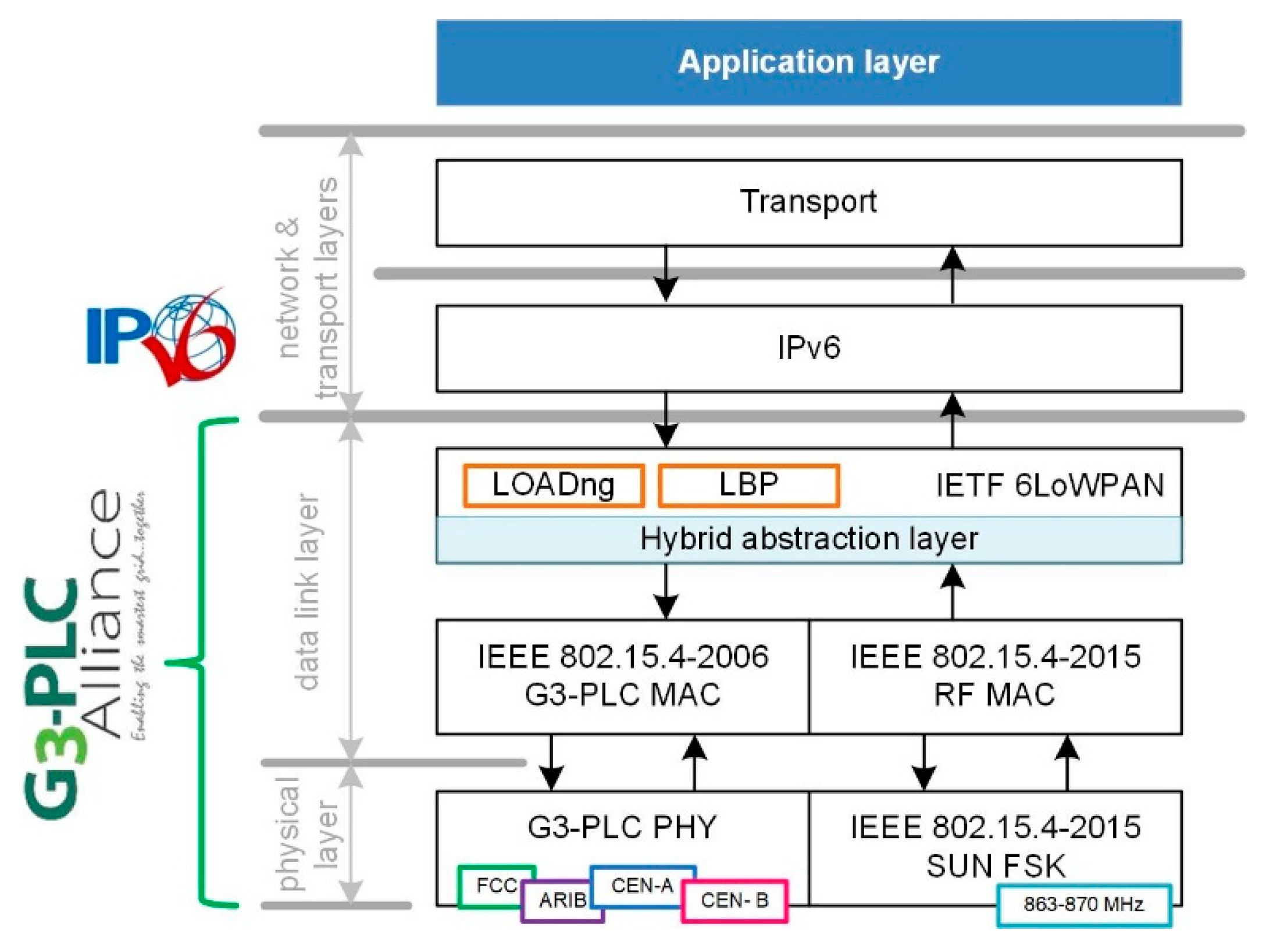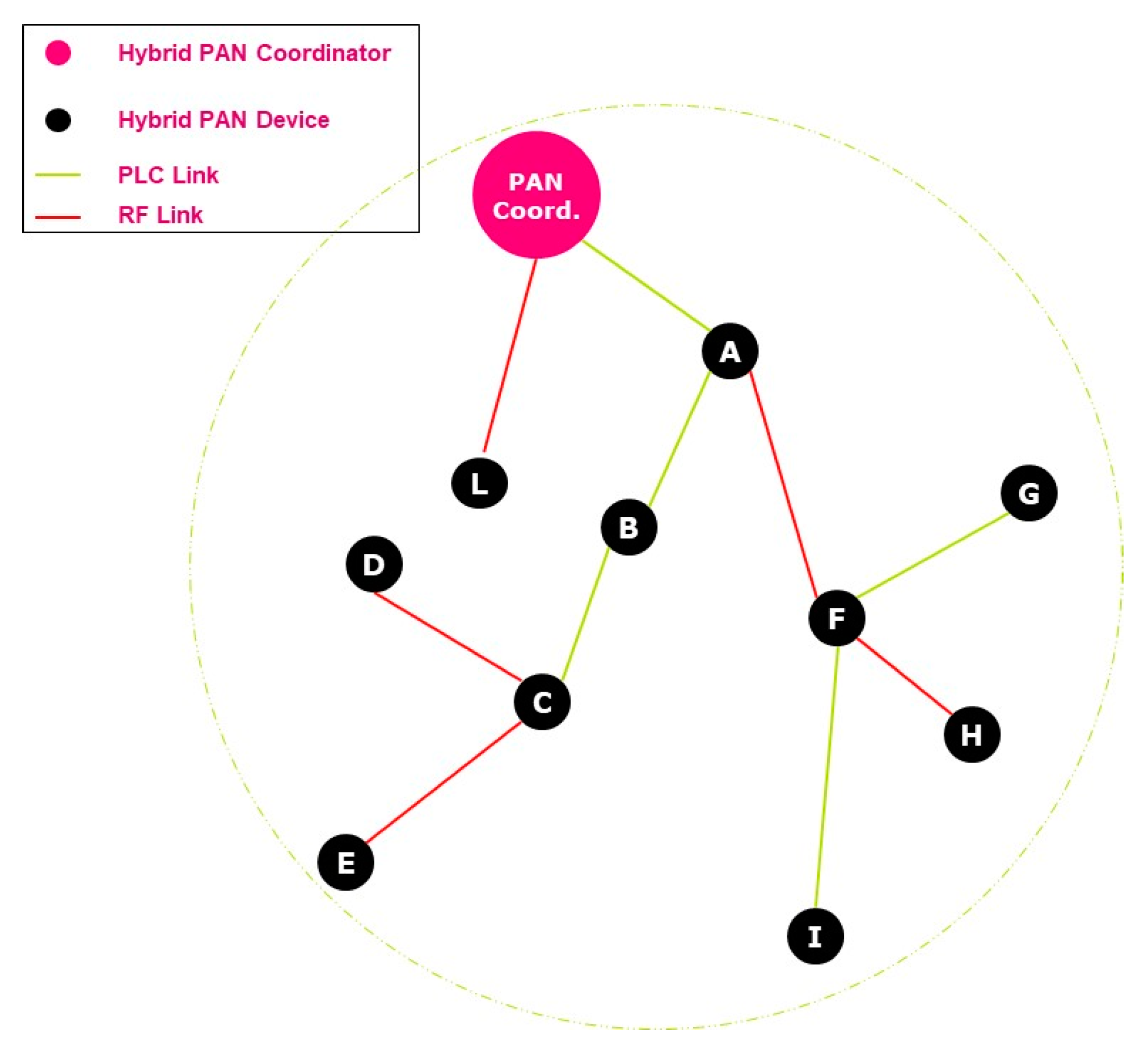When a single G3-PLC network counts more than 400 nodes, it can be categorized as a dense network. In dense networks, it is easier to reach the capacity limit when the application traffic increases. This can be problematic for DSOs willing to implement use cases beyond smart meter reading, such as intraday reading or demand response.
When observing G3-PLC traffic in a real 800-node network using a sniffer installed in the low voltage substation close to the data concentrator, it can be established that more than a half of the packets captured over the observation period are broadcast packets generated by the LOADng protocol [
1], which is the default routing mechanism in G3-PLC networks operating within the 6LoWPAN Adaptation layer (upper data link layer). More specifically, these broadcast packets correspond to the LOADng RREQ (Route Request) messages
Table 1 refers to. The principles of the LOADng routing protocol are briefly reminded in
Section 4.1.1.
In dense networks, this behaviour can be explained by unstable routes due to frequent data packet loss as the G3-PLC network is operated close to its capacity limit. Despite the use of CSMA/CA, many nodes try to access the transmission channel at roughly the same time, which comes in addition to the hidden node problem and increases the risk of frame collisions. In this situation, data packet loss implies transmission retries and finally route breakages. The routes are continuously repaired, according to the LOADng principles, which creates even more congestion due to the broadcasting of RREQ messages, leading to a higher probability of packet loss and reducing the bandwidth available for application layer traffic. This series of events leads to a self-perpetuating cycle.
In parallel, beyond the operation of the routing protocol, the G3-PLC Alliance has also recognized that there is room for improvement with respect to the existing broadcast mechanism of data frames, which is hardly efficient in dense networks. Indeed, for both LOADng and data transmission, broadcast propagation is based on the flooding principle, i.e., all nodes in the network will propagate the information to other nodes by retransmission of the received data frame.
Section 4.1.2 shows how the current design of the data broadcast mechanism has been upgraded.
4.1.1. Enhanced Routing with the RREQ Jittering Mechanism
For each destination node towards which a route is sought, LOADng consists of broadcasting RREQ messages through the network towards this destination node (flooding). The selection of the best route is done by the destination node after reception of various copies of the original RREQ message. Each copy of the original RREQ message carries a Route Cost (RC) computed during its propagation along the path towards the destination node. The RC, specific to each copy, is an aggregation of the Link Costs (LC) computed at each intermediate hop. Annex B of ITU-T G.9903 [
1] specifies a default calculation method: in its basic variant, the LC varies according to the Link Quality Indicator (LQI), based on the SNR, and the number of intermediate hops (hop count). The route with the lowest RC is selected, and the destination node sends a Route Reply (RREP) message in unicast back to the RREQ originator node, along this route. During the hop-by-hop propagation of the RREP, the route is installed in the intermediate nodes which will act as relays for subsequent data traffic.
When RREQ messages are flooded over the network they count on the sole underlying CSMA/CA access method to spread them over time. For a given route establishment procedure, when receiving multiple copies of the same original RREQ (having been forwarded along different paths and therefore carrying a different RC) over time, an intermediate node forwards a RREQ message only if the RC of the new RREQ is lower compared to the RC of the last forwarded RREQ. Relying only on CSMA/CA when broadcasting RREQ messages is not always efficient, especially in large networks, as some RREQs could be afflicted by collisions or could not be transmitted as the channel is busy. As a consequence, some good routes may be lost unexpectedly.
Therefore, the new revision of the G3-PLC specifications will include a controlled jittering mechanism applied when forwarding RREQ messages. By doing so, intermediate nodes help increasing the chances that the route with the lowest RC is always selected by the RREQ destination node. For a given route establishment procedure, after the reception of the first RREQ message, an intermediate node evaluates the jitter time based on the LQI measured for this message. During this period, the intermediate node puts the RREQ message in a queue. If a new RREQ message with lower RC is received, the original RREQ in the queue is overwritten, lowering the flooding, and increasing the probability of forwarding only RREQs that may be selected by the RREQ destination node.
Figure 9 shows an example of the calculated jittering delay as a function of the LQI.
Messages with low LQIs are put in the queue for a longer time as they were received through unreliable links with poor SNR. Similarly, messages with high LQI, probably received from a very close neighbour node, are put in the queue as well: favouring short links results in a route with more hops to the destination, which is not the best solution either. LQIs with intermediate values are linearly interpolated. In
Figure 9, RREQs with an LQI value equal to 86 (corresponding to a 12 dB SNR) are chosen as most suitable for immediate forwarding.
The implementation of this mechanism has been verified performing route discoveries from the coordinator to all the nodes in the scenario shown in
Figure 10: 10 groups formed of approximately 10 nodes (total number of 101 nodes) considering three topologies with 0, 10 and 20 dB attenuations between each group of nodes.
As reported in
Table 2, three main use cases have been tested: use_case_0 corresponds to the default configuration of the G3-PLC protocol stack (no RREQ jittering), use_case_1 and use_case_2 apply RREQ jittering with different values for “Low LQI” and “High LQI.” These two parameters quantify the penalty introduced by the LQI in LC computation (cf. Annex B of [
1]): use_case_1 corresponds to the default setting, while use_case_2 favours a progressive penalty within the actual range of SNR values encountered in the field.
Figure 11a shows the average number of RREQ messages received by one node. When comparing use_case_0 and use_case_1, the number of received RREQs is decreasing when RREQ jittering is applied, showing an overall network flooding reduction for all three topologies. When RREQ jittering is enabled, intermediate nodes delay the forwarding of RREQ messages not carrying an optimal RC. Thanks to the jittering mechanism, the probability that those RREQs will be overwritten by a better one is increased, as represented in
Figure 11b.
The absolute number of overwritten RREQ messages strongly depends on both network topology and routing parameters. In the 0 dB topology (blue lines), the network is more congested since all nodes are in the same collision domain, and the probability of collision between RREQs is higher. In the 20 dB topology (green lines), groups of nodes are separated in several collision domains due to the high attenuations. The 10 dB topology (red lines) corresponds to a mixed scenario, where a node of a given group can receive messages from nodes located in the closest groups. For use_case_2, low LQI and high LQI settings enable a more accurate RC computation based on realistic SNR values, which improves the forwarding decision made by each intermediate node.
As shown in this section, RREQ jittering as a function of the LQI can significantly reduce LOADng overhead in dense networks. In addition, care should be taken to correctly choose the parameters affecting the weight of LQI in the LC computation formula as defined in [
1].
4.1.2. Enhanced Data Broadcast Mechanism Using the Trickle Algorithm
Broadcast transmissions are used for route establishment but also for data distribution based on the 6LoWPAN broadcast mechanism [
13]. The broadcast flooding mechanism as specified in the current version of ITU-T G.9903 [
1] makes use of the 6LoWPAN broadcast header (LOWPAN_BC0) as specified in RFC 4944 [
13], which uniquely identifies frames belonging to the same flooding event. The broadcast log table holds information about all previously received broadcast frames, and thanks to the broadcast header, it ensures that each node in the network will trigger a retransmission exactly once for a given flooding event.
This mechanism provides a high level of redundancy since all nodes in a network contribute to data propagation during the flooding event. While this high level of redundancy might be beneficial in theory, in reality, it leads to several problems caused by the limited resource of transmission channel availability, especially in dense networks as previously explained in
Section 4.1.
To avoid overloading the shared transmission channel, the redundancy provided by the broadcast mechanism should be controlled, i.e., only provide redundancy to the extent needed to propagate the information through the entire network. To achieve that goal, the broadcast flooding mechanism has been extended with concepts described by “The Trickle Algorithm” defined in RFC 6206 [
14]. One of the fundamental concepts of “Trickle” is to consider retransmissions of data frames only if the redundancy in the network is not sufficient. The measurements of redundancy in this case are based on a count of received frames of a given flooding event in a given period of time. If sufficient frames from a flooding event have already been received from other nodes in the neighbourhood, a given node will suppress its own retransmission. Based on this concept, the optimized algorithm for broadcast propagation looks as follows:
IF (SrcAddr, SeqNumber) exists in broadcast log table
Increment counter c by 1
Discard frame
ELSE
Create entry with (SrcAddr, SeqNumber) in broadcast log table
Set counter c to 0
Choose an interval I between [Imin, Imax]
Choose a duration t in the interval [I/2, I]
Wait for duration t
IF (c < Ki)
- ○
Trigger the frame transmission
ELSE
- ○
Discard frame
The parameter I
min determines the minimum interval length, I
max, the maximum interval length (I
max resulting from a multiplication of I
min by a predefined factor) and Ki, the redundancy constant. The relation between these parameters and the mechanism itself is shown in
Figure 12.
In contrast to the original Trickle algorithm, as defined in RFC 6206 [
14], interval doublings are not considered here. For the relation of I
min and K
i, RFC 6206 [
14] recommends that “a protocol should set K
i and I
min such that I
min is at least two to three times as long as it takes to transmit K
i packets”. The size of broadcast messages may vary between some 10 s of bytes for control messages and several 100 s of bytes for firmware update messages. Therefore, to avoid preconfiguring I
min to a fixed value based on the longest frames and its negative impact on the latency for smaller control frames, I
min is computed adaptively based on the size of the incoming broadcast frame
where t
frame is the duration of the received broadcast frame, K
i_max the pre-configured upper bound of K
i and 3 the recommended factor from RFC 6206 [
14].
In addition, according to [
14], the redundancy constant K
i should be a pre-configured value between 1 and 5, with the default set to 3. However, to better reflect the differences in network topologies expected for various use cases of the G3-PLC technology, the redundancy constant can alternatively be derived adaptively based on the density of the network, as also suggested in [
15]. As a measure for the network density (i.e., the number of nodes in the neighbourhood of a given node), the number of entries in the node’s POS table (Personal Operating Space) is considered
where N
POS corresponds to the number of POS table entries and S is a pre-configured constant for mapping the number of POS table entries to the redundancy constant. The adaptive computation of K
i then assumes that a higher redundancy will be observed in dense network topologies where the node’s POS table will contain a larger number of entries.
The proposed optimized broadcast propagation algorithm has been evaluated in a G3-PLC test environment. The general setup for the tests is given as follows:
Test network: 329 nodes, 2 ROBO hops
Interval between flooding events: 15 s
Frame size: 350 bytes (approximately 460 ms).
Two performance criteria were used for the evaluation, i.e., the error rate, given as the average percentage of broadcast frames, which have not been received by nodes in the network, and the drop rate, given as the average percentage of frames dropped by nodes in the network because the condition c < K
i was not met. Higher drop rates lead to a lower number of messages in the network, reducing the risk of collisions and channel access failures. The test results are summarized in
Figure 13 for different combinations of parameters.
The reference test has been performed with the default broadcast propagation mechanism based on uncontrolled flooding; due to collisions and channel access failures, more than 25% of the frames do not reach their destination. For the remaining tests, the improved controlled flooding mechanism was used. Considering that the typical number of POS table entries in the test environment is more than 50, the setting of step size S = 5 practically leads to a static configuration of Ki = Ki_max. The results show that the drop rate depends on the relation between Ki and Imax. Small Ki in combination with large Imax yield high drop rates, whereas large Ki leads to low drop rates. This is expected behaviour since Ki determines the level of redundancy in the flooding event. The error rate is reduced to below 15% for the first set of parameters where Imax = 2. Further reduction to ~1% error rate has been achieved by increasing this value, i.e., Imax = 8. The last set was performed with S = 50, which yields an adaptive setting of Ki for each node in the network depending on the number of entries in the POS table. With the combination of S = 50, Ki_max = 3 and Imax = 4, the resulting error rate becomes ~0% in the test environment.
Since the test results obtained during evaluation showed significant improvement compared to the currently specified data broadcast mechanism, the improved mechanism will be adopted in the next revision of the G3-PLC specifications. Once the mechanism has been integrated into final products, further parameter optimization under real-world conditions can be performed to maximize the mechanism’s performance.
